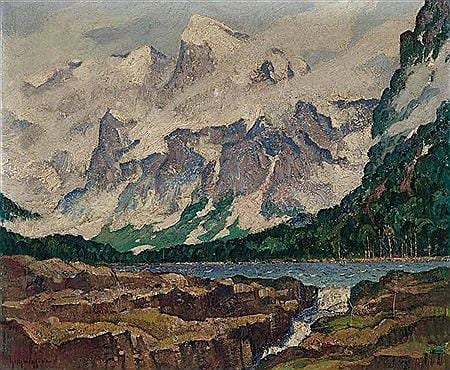Guy C. Wiggins, Winter
From his studio window in Manhattan, Guy C. Wiggins could look down Madison Avenue and see the Metropolitan Life Tower which, in 1912, was the tallest building in the world. The design of the elegant Met Life Tower was based on St. Mark's Campanile in Venice.
What Wiggins saw on a cold day in New York, was a hazy cityscape that contrasted the softness of the snowfall with the hard edges of the buildings. His palette was subdued, and yet the colors appeared to become illuminated by the snowfall.
Wiggins was born in Brooklyn. His first art teacher was his father, the illustrious painter, Carlton Wiggins. Wiggins first studied architecture at Brooklyn's Polytechnic Institute before transferring to the National Academy of Design to pursue a career as a painter. His interest in architecture, combined with his brilliant ability to harmonize colors, contributed to his skill at capturing the beauty of the city in winter.
When he exhibited the Metropolitan Tower painting, it was purchased by the Metropolitan Museum of Art, making Wiggins the youngest living American artist to have a painting in the Met's permanent collection. The city winter scenes that Wiggins continued to paint, often from the Manhattan offices of friends, established his reputation and elevated his stature as one of America's finest artists.
Guy C. Wiggins, Spring
Although his father has two paintings in the Smithsonian, Guy C. Wiggins has three in the Smithsonian and two of his works graced the walls of the White House.
Wiggins completed several paintings, including The White House in Spring, from the lawn of the White House, one of which eventually was placed in the Eisenhower Museum in Abilene, Kansas, after hanging in the president's office.
It was while he was painting a summer scene that Wiggins reportedly looked out the window at the swirling snow in Manhattan, and was inspired to paint the Met Life Tower. He said that he preferred to paint in summer, but the winter scenes were in great demand, and so, he continued to paint them.
In 1925, Wiggins was commissioned by the Great Northern Railroad to create a series of paintings in Glacier National Park. The series is not only beautiful, but a departure from Wiggins' impressionist style. Also a departure from the snowy cityscapes that he is known for, are the paintings, like Mediterranean Harbor that he made while traveling in Europe.
Guy C. Wiggins, Fall
Wiggins spent summers in Lyme, Connecticut, where he established the Guy Wiggins Art School, and painted the Connecticut landscape in all seasons. The country landscape was very conducive to his broad, quick brush stroke technique. His fall paintings of Connecticut, made in his impressionist style, with a uniquely American feel, mark Guy C. Wiggins as one of America's last, great impressionists.
Guy C. Wiggins at the Surovek Gallery
Please contact us for more information about Snowstorm in Midtown Manhattan and the other fine works of Guy C. Wiggins, currently available in our gallery.




